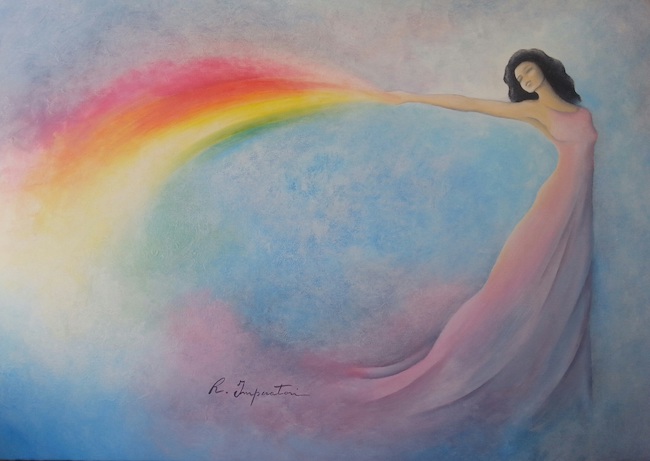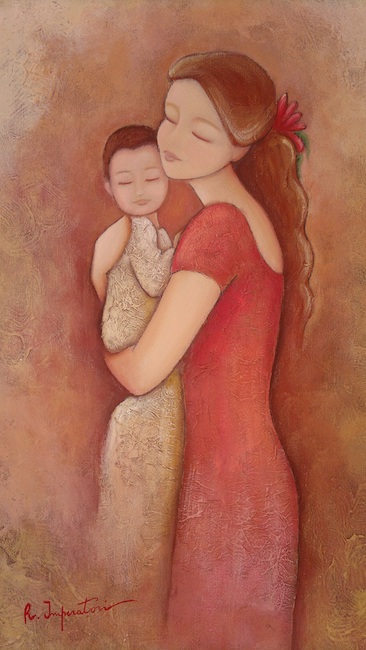L’evasione dalla contingenza, da una realtà che appare stretta, troppo dura o priva di fantasia, è una tendenza che ha contraddistinto il cammino di molti artisti del passato e che caratterizza anche molti contemporanei, dando così corpo a un mondo fantastico, sognante o solo enigmatico all’interno del quale depositare emozioni, desideri, bisogno di trovare una dimensione differente da quella quotidiana. La protagonista di oggi racconta di un universo ideale in una terra poetica dentro cui rifugiarsi per ritrovare le sensazioni più pure e liriche.
In qualsiasi momento storico in cui la contingenza diveniva troppo complessa o dolorosa da accettare, gli artisti hanno trovato una scappatoia emozionale, dando origine a correnti pittoriche in cui la spiritualità e il sentire dell’individuo dovevano prevalere sulla realtà circostante in quanto unico modo per non perdersi e lasciarsi sopraffare dagli eventi esterni. Il Simbolismo fu il primo movimento in cui si volle cercare un contatto con la spiritualità ponendo l’accento sulla rappresentazione dell’oggetto filtrata attraverso il sentire del soggetto; con l’avvicinarsi del Ventesimo secolo e l’incertezza sul futuro provocata dai venti di guerra, l’Espressionismo affermò l’esigenza di liberare le proprie paure, le angosce ma anche l’irriverenza nei confronti dell’ipocrisia della vita borghese apparentemente impermeabile agli accadimenti circostanti e alla vita difficoltosa della classe operai, attraverso un tipo di pittura forte, intensa, in cui tutte le regole classiche furono sovvertite e dove colore doveva necessariamente accordarsi al sentire interiore dell’artista, anche a costo di apparire irreale. Poco dopo il Surrealismo si propose invece di esplorare i mondi paralleli, le inquietudini dell’inconscio e degli incubi alimentati dall’osservazione delle devastazioni dei conflitti mondiali e dalla consapevolezza della fuggevolezza dell’esistenza. Malgrado il forte impatto emozionale e psicologico di queste tre correnti si percepiva ancora un forte legame con la contingenza, la causa di partenza di un distacco che era condizione necessaria per la sopravvivenza dello spirito, di un’interiorità troppo fragile e dunque necessitante di essere protetta, di trovare una valvola di sfogo, più o meno mentale e consapevole, per uscire fuori dal buio. A partire dagli anni Venti del Novecento cominciò a delinearsi però un ritorno all’ordine, un bisogno di restare più attaccati alla realtà pur evidenziandone l’enigma, l’insolito che si nasconde dietro ciò che è ordinario e da questa nuova esigenza nacque il Realismo Magico; il movimento di cui furono protagonisti in Italia Ubaldo Oppi e Felice Casorati, le cui opere lasciavano emergere quel senso di estraniamento dei protagonisti quasi disorientati dall’ordinarietà in cui venivano ritratti, ebbe una successiva evoluzione a partire dagli anni Cinquanta in avanti, a seguito della quale la realtà si sovrappose via via in maniera più incisiva al sogno, all’aspetto lirico e sospeso nel tempo dei protagonisti fino a mescolarsi con il Surrealismo Metafisico escludendone però l’inquietudine e lasciando spazio alla serena tendenza verso l’irrealtà, verso un universo ideale, come nelle opere di Balthus e del contemporaneo Vladimir Kush. L’artista romana Roberta Imperatori apre la sua porta creativa verso un mondo magico, poetico, un rifugio soffice all’interno del quale coltivare le sensazioni più pure, immediate, semplici, quelle che lasciano fuoriuscire un desiderio di armonia, di piacevolezza che può avvolgere l’esistenza nel momento in cui si osserva tutto con lo sguardo di un fanciullo.
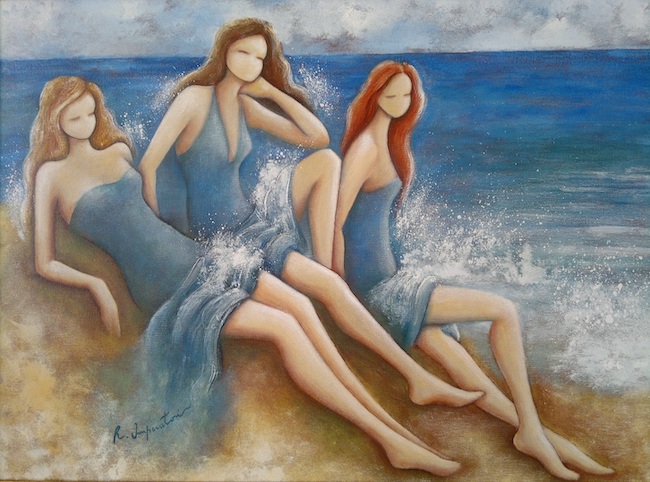
Il suo stile è lirico, tanto quanto la scelta della gamma cromatica con la quale accompagnare, o sarebbe meglio dire accarezzare, le sue protagoniste, sempre donne, come se la femminilità implicasse imprescindibilmente la capacità di trascinare verso un contatto con l’emozione, con la sensibilità a cui l’uomo spesso dimentica di avvicinarsi, e che induce l’osservatore a lasciarsi andare a quella melodia visiva fatta di serenità. Non solo, ciò che emerge chiaramente dalle opere della Imperatori è un legame con l’arte e la cultura a tutto tondo, con quell’interazione tra talenti espressivi che amplificano l’incanto visivo delle sue tele; musica, danza, lettura, tutto viene evidenziato come se l’artista consegnasse alla figura femminile la capacità di tramandare, di diffondere quelle capacità sottili ed emozionali di cui l’essere umano ha bisogno di avvolgersi.
La donna dunque non solo come generatrice di vita, di amore materno e di forza interiore, che Roberta Imperatori descrive abilmente nella suggestiva tela Maternità, in cui le due figure protagoniste, la mamma e il bambino, vengono narrate nella loro posa più tenera, sospese al di fuori di un contesto reale, come se ciò che l’artista volesse far emergere fosse il sentimento più elevato, quello dell’amore materno in grado di dare protezione, calore, trasporto e dolcezza, tutte emozioni che emergono dagli occhi chiusi e dall’abbraccio avvolgente. Le tonalità sono cipriate, polverose sebbene i toni prevalenti siano quelli del rosa, dell’arancio tenue, del beige, a sottolineare la delicatezza del gesto immortalato.
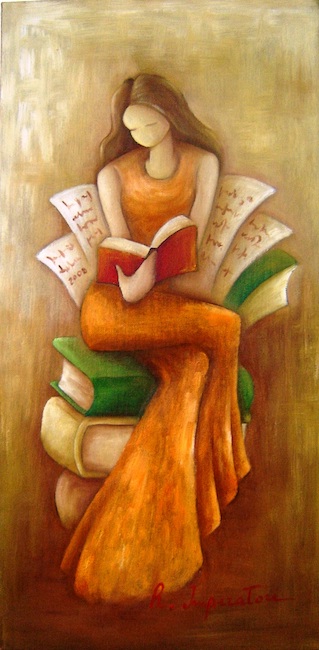
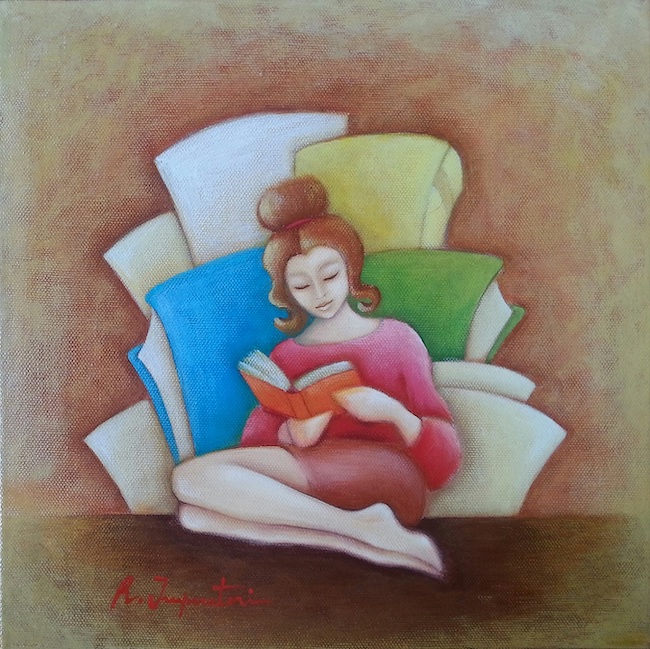
Nelle opere Cultura e La lettrice, Roberta Imperatori pone l’accento sull’importanza della lettura intesa come mezzo per apprendere nozioni e conoscenze ma, soprattutto, per stimolare l’apertura mentale che consente all’individuo di ragionare, di crearsi una propria opinione sulla base di una poliedricità di informazioni e non solo ascoltando una sola voce; quello dell’artista è un invito a non lasciarsi oscurare dall’era contemporanea fatta di informazioni virtuali, di velocità di notizie che non lasciano spazio all’approfondimento, e di non fermarsi alla superficie del patinato che appare in televisione e sui social media bensì di darsi la possibilità di conoscere di più, di scoprire il passato per vivere meglio il presente, di lasciarsi affascinare dal lento scorrere delle pagine di un libro per assaporarne ogni dettaglio, ogni frase. La Imperatori sospende l’ambiente che circonda le protagoniste di queste due tele, come se tutto ciò che necessitano si nascondesse dentro le storie lette, o ancora da leggere, come se il silenzio che le avvolge fosse rassicurante e in accordo con il desiderio della mente di apprendere.
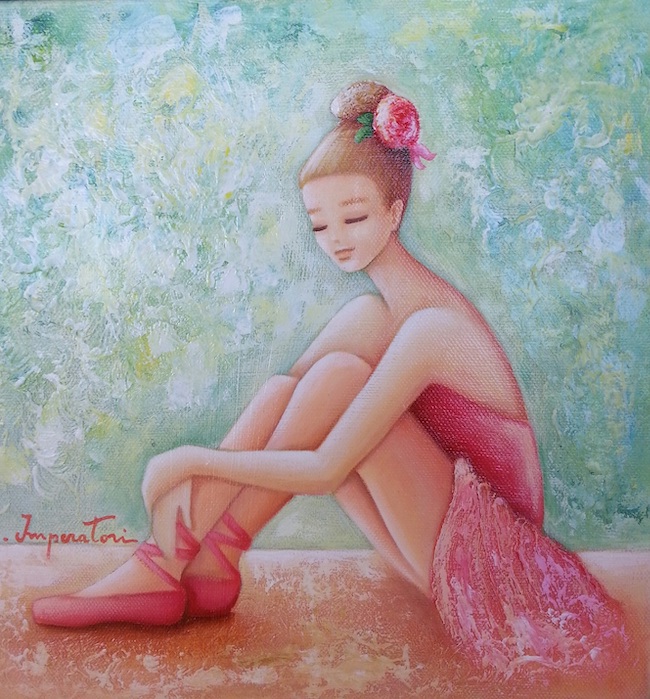
L’amore dell’artista per ogni forma d’arte emerge anche dal dipinto La ballerina, in cui la protagonista è raffigurata in un momento di pausa, proprio per mettere in evidenza il piacere dell’esercitare una disciplina che la ragazza ama, a cui si sente affine e che le permette di entrare in armonia con il proprio corpo, con la musica, con la consapevolezza di potersi esprimere con naturalezza e concentrazione nell’eseguire figure e volteggi. Anche in questo caso l’atmosfera circostante è tenue, come fosse un accompagnamento melodico alla posa, e arricchita da velature che impreziosiscono lo sfondo ma anche alcuni dettagli, in accordo con la definitezza della pelle rosata e dell’espressione sognante della giovane donna.
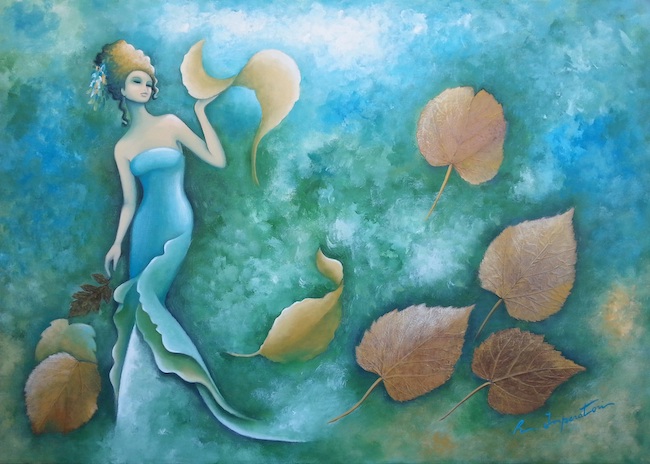
Nella tela La metamorfosi delle idee a essere protagonista è una donna avvenente, elegante, con un abito sontuoso, che sembra voler affidare alle foglie, e dunque all’incontro con la natura, i suoi desideri, i sogni, le speranze e anche il desiderio di rivelazione interiore, una tensione verso la scoperta di una se stessa più concentrata sulle cose importanti, su quell’evoluzione per raggiungere la quale è necessario un percorso introspettivo; dunque la ragazza si affida alla naturalezza del mondo circostante per interrogarsi su quanto ha vissuto fino a quel momento, su quanto le sue priorità siano state orientate a coltivare l’esterno e l’interno di sé oppure quanto l’abbiano allontanata da ciò che davvero conta. Da questa opera emerge la consapevolezza, così come la possibilità, di effettuare quel cambiamento, quella metamorfosi, appunto, a seguito della quale acquisire una maggiore coscienza di sé e generare una nuova scala di valori esattamente in virtù del nuovo approccio, delle nuove idee che dall’analisi derivano.
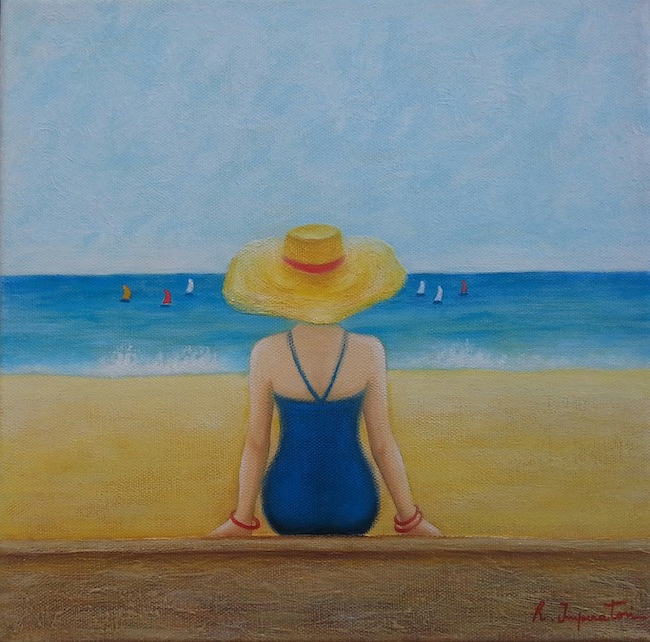
Roberta Imperatori, con una ventennale esperienza nel campo dell’arte, ha all’attivo la partecipazione a molte mostre collettive in Italia e all’estero, è socia dell’Accademia Internazionale di Arte Moderna di Roma, è nel Consiglio Direttivo dell’Associazione Cento Pittori di via Margutta, dal 2021 è nell’Enciclopedia dell’Arte Italiana e dal 2022 sarà inserita anche nel volume cartaceo.
ROBERTA IMPERATORI-CONTATTI
Email: roberta.imperatori@gmail.com
Sito web: https://www.pitturacontemporanea.com/
www.robertaimperatori.it
Facebook: https://www.facebook.com/roberta.imperatori.7
Instagram: https://www.instagram.com/_roberta.imperatori_/
The poetic and dreamy femininity of Magic Realism by Roberta Imperatori
The escape from contingency, from a reality that seems narrow, too hard or lacking in imagination, is a tendency that has marked the path of many artists of the past and that also characterises many contemporaries, thus giving body to a fantastic, dreamy or just enigmatic world within which to deposit emotions, desires, the need to find a different dimension from the everyday one. Today’s protagonist tells of an ideal universe in a poetic land in which to take refuge in order to find the purest and most lyrical sensations.
At any time in history when contingency became too complex or painful to accept, artists found an emotional loophole, giving rise to pictorial currents in which the spirituality and feeling of the individual had to prevail over the surrounding reality as the only way not to get lost and be overwhelmed by external events. Symbolism was the first movement to seek contact with spirituality by emphasising the representation of the object filtered through the feeling of the subject; with the approach of the 20th century and the uncertainty about the future caused by the winds of war, Expressionism affirmed the need to release one’s fears, anxieties but also irreverence towards the hypocrisy of bourgeois life, apparently impervious to the surrounding events and the difficult life of the working class, through a strong, intense type of painting, in which all the classical rules were subverted and where colour had to match the artist’s inner feelings, even at the cost of appearing unreal. Shortly afterwards, Surrealism instead set out to explore parallel worlds, the anxieties of the unconscious and nightmares fuelled by the observation of the devastation of world conflicts and the awareness of the fleeting nature of existence.
Despite the strong emotional and psychological impact of these three currents, there was still a strong link with contingency, the root cause of a detachment that was a necessary condition for the survival of the spirit, of an interiority that was too fragile and therefore needed to be protected, to find a vent valve, more or less mental and conscious, to emerge from the darkness. From the 1920s onwards, however, a return to order began to emerge, a need to remain more attached to reality while highlighting its enigma, the unusual that hides behind what is ordinary, and this new need gave rise to Magic Realism; the movement, whose protagonists in Italy were Ubaldo Oppi and Felice Casorati, whose works brought out the sense of alienation of the protagonists, almost disorientated by the ordinariness in which they were portrayed, evolved from the 1950s onwards, after which reality gradually overlapped more and more incisively with the dream, with the lyrical aspect of the protagonists, suspended in time, until it mixed with Metaphysical Surrealism, but excluding its restlessness and leaving room for the serene tendency towards unreality, towards an ideal universe, as in the artworks of Balthus and the contemporary Vladimir Kush.
The Roman artist Roberta Imperatori opens her creative door to a magical, poetic world, a soft refuge within which to cultivate the purest, most immediate, simple sensations, those that let out a desire for harmony, for the pleasantness that can envelop existence when everything is observed with the gaze of a child. Her style is as lyrical as the choice of colour range with which she accompanies, or rather caresses, her protagonists, who are always women, as if femininity inescapably implies the ability to draw towards a contact with emotion, with the sensitivity that men often forget to approach, and which induces the observer to let himself go to that visual melody made of serenity. What emerges clearly from Imperatori’s works is a link with art and culture all round, with that interaction between expressive talents that amplify the visual enchantment of her canvases; music, dance, reading, everything is highlighted as if the artist were giving the female figure the capacity to pass on, to spread those subtle and emotional capacities that the human being needs to embrace. The woman, therefore, not only as a generator of life, maternal love and inner strength, which Roberta Imperatori skilfully describes in the evocative painting Maternity, in which the two protagonist figures, mother and child, are portrayed in their most tender pose, suspended outside a real context, as if what the artist wanted to bring out was the highest sentiment, that of maternal love capable of providing protection, warmth, transport and sweetness, all emotions that emerge from the closed eyes and the enveloping embrace.
The tones are powdery, dusty, although the prevailing tones are pink, soft orange and beige, underlining the delicacy of the immortalised gesture. In the paintings Cultura and La lettrice, Roberta Imperatori emphasises the importance of reading as a means of learning notions and knowledge but, above all, of stimulating an open mind that allows the individual to reason, to create his own opinion on the basis of a variety of information and not just by listening to a single voice; that of the artist is an invitation not to be obscured by the contemporary age of virtual information, of fast-moving news that leaves no room for in-depth analysis, and not to stop at the surface of the glossy material that appears on television and social media, but to give oneself the chance to learn more, to discover the past in order to live the present better, to allow oneself to be fascinated by the slow flow of the pages of a book in order to savour every detail, every sentence. Imperatori suspends the environment surrounding the protagonists of these two canvases, as if everything they need was hidden within the stories they have read, or are yet to read, as if the silence that envelops them is reassuring and in keeping with the mind’s desire to learn. The artist’s love for every form of art is also evident in the artwork The Dancer, in which the protagonist is shown in a moment of pause, precisely to highlight the pleasure of practising a discipline that the girl loves, to which she feels attached and which allows her to enter into harmony with her body, with music, with the awareness of being able to express herself naturally and with concentration in performing figures and vaults. Here too the surrounding atmosphere is soft, as if it were a melodic accompaniment to the pose, and enriched by veils that embellish the background but also certain details, in accordance with the definition of the young woman’s rosy skin and dreamy expression.
In the painting The Metamorphosis of Ideas, the protagonist is an attractive, elegant woman in a sumptuous dress, who seems to want to entrust her desires, dreams, hopes and also the desire for inner revelation to the leaves, and thus to the encounter with nature, a tension towards the discovery of a self that is more focused on important things, on that evolution for which an introspective path is necessary; thus the girl relies on the naturalness of the world around her to question herself about what she has experienced up to that moment, about how far her priorities have been oriented towards cultivating the outside and the inside of herself or how far they have distanced her from what really counts. From this artwork emerges the awareness, as well as the possibility, of making that change, that metamorphosis, as a result of which she acquires greater self-awareness and generates a new scale of values precisely by virtue of the new approach, the new ideas that derive from the analysis. Roberta Imperatori, with twenty years of experience in the field of art, has taken part in many collective exhibitions in Italy and abroad, is a member of the International Academy of Modern Art in Rome, is on the Board of Directors of the Associazione Cento Pittori di via Margutta, since 2021 she has been in the Encyclopaedia of Italian Art and from 2022 will also be included in the printed volume.


